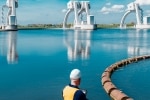Utilities in the Gulf Cooperation Council countries are facing new challenges as governments push them to modernize and expand their operations to support economic diversification and adapt to the energy transition. To rise to these challenges and adjust to new regulatory requirements, utilities need to eliminate inefficiencies and reallocate resources to strategic investments. These investments include spending to upgrade their infrastructure, enhance digitization, and reskill the workforce for the future.
Common misconceptions exist about utility costs. We outline paths for utilities in GCC countries as they seek to navigate these changing circumstances and reject these myths. Leading practices elsewhere, particularly in Europe, where new regulatory frameworks have enabled utilities to cut operational expenditures and simultaneously improve their service quality, could serve as a guide.
GCC utilities can save money by decoupling revenues from growth in operational expenditures
(Revenues and total Opex with constant operational costs, US$)

Note: Opex = Operating expenditure.
Source: Strategy& analysis, GCC utilities’ public financial data
Keeping operational expenses under control inherently generates efficiencies. If GCC utilities could keep operational costs constant at today’s levels, the decrease of the cost-to-serve as implied by the growth in output would be significant—as much as US$70 billion over the next decade. That alone would enable utilities to bridge a significant gap in their funding requirements in that period.
Our analysis suggests that through a combination of short-term tactical actions and longer-term changes to their operating model, utilities in the GCC region could cut operational costs by between 15 and 30 percent. That would translate into savings of as much as US$22 billion over the next decade—gains that could position the region’s utilities as significant enablers of their respective national economic growth and sustainability goals.
Achieving cost optimization of this magnitude is inevitably challenging. It requires agile governance and strong leadership support, careful alignment of cost savings targets, effective stakeholder engagement and communications, integrated change management, and adequate resources and internal funding. However, acting on costs is a necessity in today’s fast-changing world. It also presents opportunities. Making utilities more efficient, agile, and resilient at a time of global energy transition can future-proof utilities and the national economies in which they operate.
In today’s environment, optimizing operational expenditures is both a necessity and an opportunity. Optimizing operating expenditures does more than cut costs—it reshapes the operational landscape to make utilities more efficient, agile, and resilient. For utilities, leadership in executing these strategies will determine whether they can meet today’s challenges and thrive as key enablers of their national economic and sustainability goals. Now is the time to build a future-ready utility that is equipped to navigate complexity while driving sustainable growth.
Contact us





















Menu